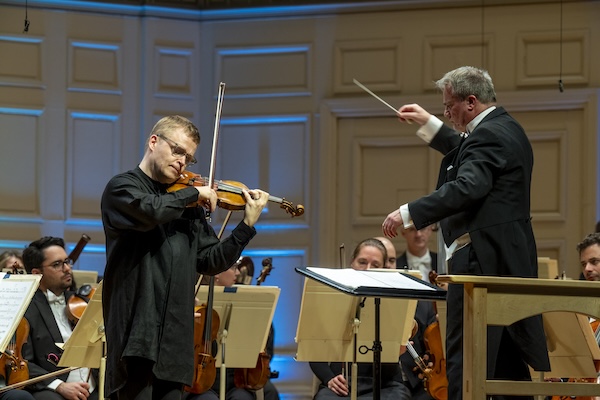BSO’s Nordic festival off to a mixed start under Storgårds

Pekka Kuusisto performed Nielsen’s Violin Concerto with John Storgårds conducting the Boston Symphony Orchestra Thursday night. Photo: Michael J. Lutch
On Thursday night the Boston Symphony Orchestra launched “Music of the Midnight Sun,” subbed “a two-week celebration of Nordic composers, conductors, performers, and culture.” The program, led by Finnish conductor John Storgårds, was divided between the Nielsen Violin Concerto and three pieces by Sibelius, as well as Finnish composer Outi Tarkiainen’s eponymous Midnight Sun Variations.
Tarkiainen’s work, which opened the evening, proved the most intriguing work on the program. The microtonal shifts in the brass and winds especially formed a clever mimesis of the strange bending of light that characterizes the atmosphere of the far north. Tarkiainen’s work is a welcome example of the innovations in soundscape-style composition over the last half-century.
The homogeneity of the programming served neither the pieces themselves nor the individual performers. All of the pieces, except the Tarkiainen, were written within the same ten-year period, by composers with similar aesthetic principles. The result was a program in which the subtle gradations of differences between the pieces were lost in sameness, rather than set off against illuminating alternatives. While the powers of the orchestra were, as ever, on fine display, the result was a concert of largely drowsy performances.
While soloist Pekka Kuusisto, who made his BSO debut on Thursday, brought his usual contemplative precision to Nielsen’s Violin Concerto, the choice of soloist seemed incompatible with the music. Kuusisto, a superb player, is known for his innovative and accessible performances and premieres of contemporary music. The strongest elements of the performance were the lyrical openings of both the first and second movements; however, the playful Allegro and Rondo that end each of those movements were lost opportunities in a piece that lives and dies by its stylish performance. The final Rondo especially lacked a charm that would have allowed Nielsen’s complex engagement with the symphonic form to have shown through.
Conductor Storgårds’ leadership felt too measured in the concerto accompaniment, which, calls for an intensity that might have really taken advantage of the BSO’s dynamic range.
As an encore, Kuusisto’s choice of a traditional Finnish folk tune was again a welcome diversion from the sameness of the program. Here, Kuuisto’s playful and accessible style showed through in a comfortable encore with the audience.
The second half of the program included three tone poems by Sibelius, The Oceanides, The Bard, and Tapiola. These three pieces all share an interest in the spiritual animation of the Nodric landscape in their evocations of figures like the ancient bard and Tapio, the ferocious god of the Nordic wild.
In these three pieces, one again felt the need for stronger creative direction from Storgårds. In the absence of predictable harmonic and melodic structure, the tone poem relies on contrast and affective release for cogency. While the orchestra was able to provide the enormous color and shimmering interest for these pieces, the performance lacked the usual magic the ensemble generally brings to work in this genre.
The Oceanides was a highlight of the evening, with the interventions of percussion, brass, and winds waking up the program substantially and creating sublime swells and releases of emotion. The Bard, featuring harp soloist Jessica Zhou, was similarly enchanting, with the wandering and sweet melodies of the harp contrasting the sweep of the Nordic landscape offered by the orchestra at large.
The longer Tapiola rounded off the evening. Here again, the fierceness of the orchestra needed greater intensity, and the quiet passages more mystery and atmosphere. Even so, the symphony again shone here, if only to remind the audience how much energy they might have brought to a program differently organized.
The program will be repeated 8 p.m. Friday night. bso.org
Posted in Performances

